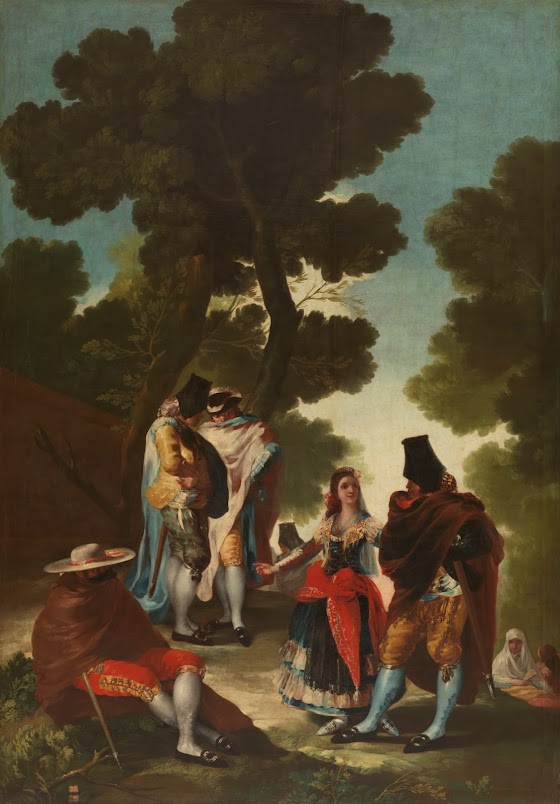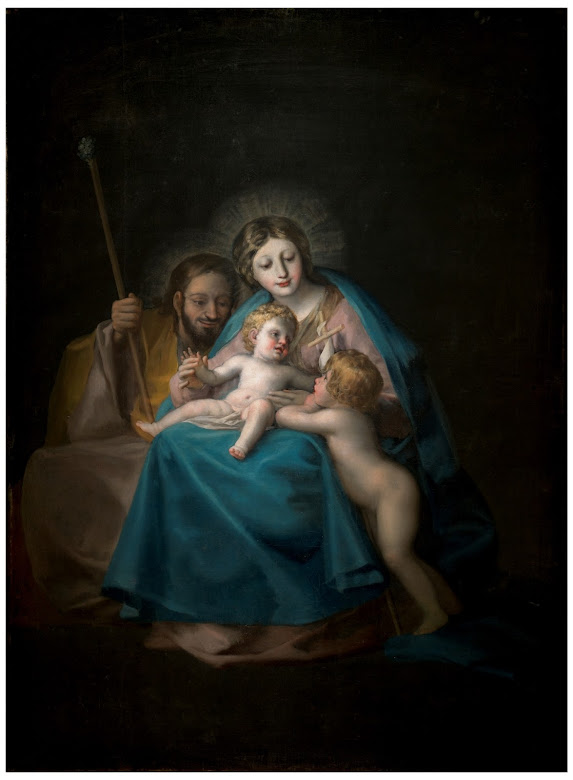%20ink%20on%20paper%209.8%20x%208.8%20cm.jpg) |
| c1790 Self-Portrait in a Cocked Hat pen and brown (iron gall?) ink on paper 9.8 x 8.8 cm |
Francisco de Goya was a Spanish artist widely considered one of the most important painters of the Romantic period. The artist took on a wide array of subject matter, including self-portraiture, fantasy scenes, landscapes, and still lifes. “Painting, like poetry, selects in the universe whatever she deems most appropriate to her ends,” he once explained. Born Francisco José de Goya y Lucientes in the town of Fuendetodos, Spain on March 30, 1746, he began studying art under the painter Jose Luzán at the age of 14. During the 1770s, Goya produced works such as The Parasol (1777), which meld the unlikely pairing of cheery Rococo aesthetics with the moody works of Diego Velázquez.
The artist became the court painter of Charles III of Spain in 1786, and continued painting for the Spanish court until Napoleons invasion of Spain in 1808. During the Napoleonic wars, Goya’s palette significantly darkened as he produced some of his most famous works. Among these paintings are the The Second of May 1808 (1814) and The Third of May 1808 (1814), which show the terrors of war. Three years before he left his native country, Goya produced 14 paintings directly onto the plaster walls of his farmhouse. These works, collectively known as The Black Paintings (1821), depicted terrifying supernatural themes and heinous violence.
Living in exile in Bordeaux, France, the artist died on April 16, 1828. His works went on to have a profound influence on both Édouard Manet and Pablo Picasso. Today, Goya’s works are held in the collections of the Art Institute of Chicago, the Hermitage Museum in St. Petersburg, the Prado Museum in Madrid, and the Louvre Museum in Paris, among others.
This is part 1 of a 10-part series on the works of Francisco de Goya:
 |
| 1770-71 The Victorious Hannibal seeing Italy from the Alps for the first Time oil on canvas 88.3 x 133 cm Museo del Prado, Madrid |
 |
| 1771-72 Angel's head sanguine, heightened with white, on brown paper 46.6 x 34.8 cm Louvre, Paris |
 |
| c1771Academia, figure seated on a section of fluted shaft holding a scroll in his hands black pencil. pen, iron gall ink on laid paper 18.7 x 13 cm Museo del Prado, Madrid |
 |
| c1771 Cain killing Abel 18.7 x 13 cm Museo del Prado, Madrid |
1772 Saint Barbara
Saint Barbara was a third-century Christian martyr imprisoned in a tower and later decapitated by her father, Dioscoro, as punishment for not wanting to marry and refusing to profess paganism. Goya depicts the saint with her various symbols, with a monstrance in her right hand and the palm frond of martyrdom in the left. She wears a crown as she was a princess. The tower is behind her, and a representation of her martyrdom appears at the right edge of the composition. Goya painted this work shortly after his visit to Italy, and it reveals his inspiration by both classical statuary and seventeenth-century classicist Italian painting. This is documented in his Italian notebook, where he studied both the head and the composition.
 |
| 1772 Saint Barbara oil on canvas 97.2 x 78.5 cm Museo del Prado, Madrid |
 |
| 1775 An Avenue in Andalusia, or The Maja and the Cloaked Men oil on canvas 275 x 190 cm Museo del Prado, Madrid |
1775 Cartoons foe tapestries on "countryside" subjects, 1st series:
 |
| 1775 A Hunter with his Hounds oil on canvas 268 x 67.5 cm Museo del Prado, Madrid |
 |
| 1775 Hunter loading his Rifle oil on canvas 292 x 50 cm Museo del Prado, Madrid |
 |
| 1775 Hunting Dogs oil on canvas 112 x 174 cm Museo del Prado, Madrid |
 |
| 1775 Hunting Party oil on canvas 290 x 226 cm Museo del Prado, Madrid |
 |
| 1775 Hunting with a decoy oil on canvas 112 x 179 cm Museo del Prado, Madrid |
 |
| 1775 The Angler oil on canvas 289 x 110 cm Museo del Prado, Madrid |
 |
| 1775 The boar hunt oil on canvas 249 x 173 cm Museo del Prado, Madrid |
 |
| 1777 A Fight at the Venta Nueva oil on canvas 275 x 414 cm Museo del Prado, Madrid |
 |
| 1777-78 Children blowing up a bladder oil on canvas 116 x 124 cm Museo del Prado, Madrid |
1777-78 The Kite
In Goya´s own words, the scene depicts some young people who have “gone out to the country to fly a kite.” The couples that appear behind the main group show that this subject is a pretext allowing the painter to represent the flirting and gallantry inherent in Majo society. The background building has been interpreted as an astronomical observatory, which was a much discussed project during Charles III’s reign.This was a customary argument in other series by Goya, such as the etchings from his Caprichos. This is one of ten cartoons for a series of tapestries on everyday subjects intended to hang in the dining room of the Prince and Princess of Asturias (the future CarlosIV and his wife (the future Maria Luisa de Parma) at El Escorial’ Access to the series of ten tapestry cartoons destined for the dining room of the Prince and Princess of Asturias at the palace of El Pardo.
 |
| 1777-78 The Kite oil on canvas 269 x 285 cm Museo del Prado, Madrid |
 |
| 1777-80 The Woodcutters oil on canvas 141 x 114 cm Museo del Prado, Madrid |
%20259%20x%20220%20cm%20Museo%20del%20Prado,%20Madrid.jpg) |
| 1778-79 The Pottery Vendor oil on canvas 259 x 220 cm Museo del Prado, Madrid |
 |
| 1779 A Fair in Madrid oil on canvas 258 x 218 cm Museo del Prado, Madrid |
 |
| 1779 Boys playing at Soldiers oil on canvas 146 x 94 cm Museo del Prado, Madrid |
 |
| 1779 Majo with a Guitar oil on canvas 137 x 112 cm Museo del Prado, Madrid |
 |
| 1779 The game of Pelota oil on canvas 261 x 470 cm Museo del Prado, Madrid |
 |
| 1779 The Haw Seller oil on canvas 259 x 100 cm Museo del Prado, Madrid |
 |
| 1779 The Military Man and the Lady oil on canvas 259 x 100 cm Museo del Prado, Madrid |
 |
| 1779 The Swing oil on canvas 126 x 165 cm Museo del Prado, Madrid |
 |
| 1780 Amateur Bullfight oil on canvas 259 x 136 cm Museo del Prado, Madrid |
 |
| 1780 Boy with Tree oil on canvas 262 x 40 cm Museo del Prado, Madrid |
 |
| 1780 The Rendezvous oil on canvas 100 x 151 cm Museo del Prado, Madrid |
 |
| 1780 The Tobacco Guards oil on canvas 262 x 137 cm Museo del Prado, Madrid |
 |
| 1780 The Washerwomen oil on canvas 257.5 x 166 cm Museo del Prado, Madrid |
 |
| 1786 Cats fighting oil on canvas 56.5 x 196.5 cm Museo del Prado, Madrid |
 |
| 1786 The Flower Girls or Spring oil on canvas 277 x 192 cm Museo del Prado, Madrid |
 |
| 1786 The Grape Harvest or Autumn oil on canvas 267.5 x 190.5 cm Museo del Prado, Madrid |
 |
| 1786-87 Boy on a Ram oil on canvas 127 x 112.1 cm Art Institute of Chicago, IL |
 |
| 1786-87 Boys with Mastiffs oil on canvas 112 x 145 cm Museo del Prado, Madrid |
 |
| 1786-87 The Snowstorm or Winter oil on canvas 275 x 293 cm Museo del Prado, Madrid |
%20oil%20on%20canvas%20277%20x%20115%20cm%20Museo%20del%20Prado,%20Madrid.jpg) |
| 1786-87 Woman with two Boys at a Fountain (“Poor People at the Fountain”) oil on canvas 277 x 115 cm Museo del Prado, Madrid |
 |
| 1775 Dogs on a Leash oil on canvas 112 x 174 cm Museo del Prado, Madrid |
 |
| 1775 Hunter loading his Rifle oil on canvas 292 x 50 cm Museo del Prado, Madrid |
 |
| 1775 The Angler oil on canvas 289 x 110 cm Museo del Prado, Madrid |
 |
| 1775-80 The Holy Family with the Infant Saint John the Baptist oil on canvas 200 x 148 cm Museo del Prado, Madrid |
 |
| 1776 Picnic on the banks of the Manzanares River oil on canvas 271 x 295 cm Museo del Prado, Madrid |
 |
| 1776-77 Dance on the Banks of the Manzanares oil on canvas 272 x 295 cm Museo del Prado, Madrid |
 |
| 1777 A Walk through Andalusia oil on canvas 275 x 190 cm Museo del Prado, Madrid |
 |
| 1777 The Drinker oil on canvas 107 x 151 cm Museo del Prado, Madrid |
 |
| 1777 The Maja and the Cloaked Men oil on canvas 275 x 190 cm Museo del Prado, Madrid |
 |
| 1777 The Parasol oil on canvas 104 x 152 cm Museo del Prado, Madrid, Spain |
 |
| 1777-78 Card Players oil on canvas 270 x 167 cm Museo del Prado, Madrid |
 |
| 1778 Boys picking fruit oil on canvas 119 x 122 cm Museo del Prado, Madrid |
 |
| 1778 Children inflating a bladder oil on canvas 116 x 124 cm Museo del Prado, Madrid |
No comments:
Post a Comment
Note: only a member of this blog may post a comment.